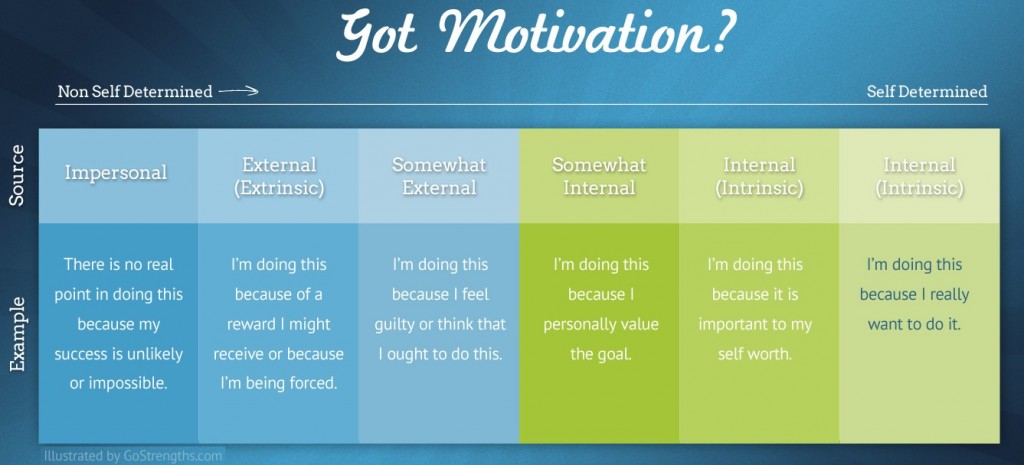The technical definition
Self-determination theory (SDT) is a framework conceptualizing the motivation which underlies the choices people make. The theory was developed by Edward L. Deci and Richard M. Ryan in the mid 1980s.
Huh? What does that mean?
Self-determination theory is all about human motivation. SDT indicates there are two basic types of motivation: intrinsic and extrinsic. Intrinsic motivation comes from within. Let’s say you’re reading a new book by your favorite author; it’s probably not difficult to motivate yourself to finish the book because it’s enjoyable! You experience intrinsic motivation when the task at hand is inherently interesting, enjoyable, fulfilling, and absorbing.
Now imagine you’re reading a book for an exam. Sure, you read the book because you know it’ll help you pass the exam, but it’s not inherently satisfying (in fact, it’s more like pulling teeth)! This is extrinsic motivation; you perform activities to reap positive external rewards or to avoid punishment.
It’s flat out better to strive toward goals from a place of intrinsic motivation. Intrinsic motivation facilitates greater concentration, effort, and task completion. But how do you nurture this type of motivation? Deci and Ryan identified three basic needs that fuel intrinsic motivation.
- Competence – the ability to control the outcome of an activity and experience mastery of that task.
- Relatedness – the universal need to be connected to and experience caring for others.
- Autonomy – the desire to be an independent agent in your own life.
How can I use this in my life?
If you spend all of your time performing boring, unimaginative, or unpleasant tasks that require extrinsic motivation, it may be time to make a change in your life. Deliberately choose tasks that require you to behave autonomously, connect with others, and feel competent. For example, you could create a study group with friends instead of reading a textbook alone to study for your test. This keeps you engaged in the task at hand, increasing intrinsic motivation.
When working with your child, try to cultivate activities that he or she finds intrinsically rewarding. Although giving rewards or doling out punishments may be your typical m.o., these are extrinsic motivators. For example, if your child is working on a science project, do not micromanage his or her performance or offer a reward for his or her work. Instead, encourage your child to come up with ideas and offer praise that supports his or her autonomy, such as saying, “Wow! I’m impressed that you thought of such a unique idea for the science fair. I’m excited to see how your experiment turns out.” This reaffirms autonomy and competence, making the task itself intrinsically motivating.
Model this behavior to your child by rejecting activities that make you feel drained or uninspired. Instead, look for ways to turn them into intrinsically motivating activities that increase your feelings of competence, relatedness to others, and autonomy. You’ll find yourself happier, more satisfied with your life, and successful at the activities you love.
References
Ryan, R. M., & Deci, E. L. (2000). Self-determination theory and the facilitation of intrinsic motivation, social development, and well-being. American Psychologist, 55, 68-78.

As a Canadian Secondary School Woodworking and Carpentry Teacher I observe this theory in action every day in most students.
Especially with those students I refer to as Activity Learners. These learners are exhausted from sitting at a desk for 9 plus years. They thrive on learning and skill development related to working with machines and power tools, moving to and from workbenches, getting materials and all the numerous motions of making and creating projects [physically working while learning].
They experience mastery of tasks using adult tools and equipment and often become more knowledgeable and skilled in these tasks than the adults at home or even their other teachers.